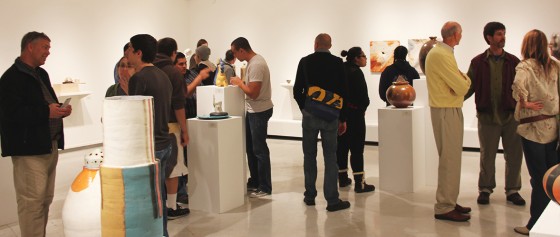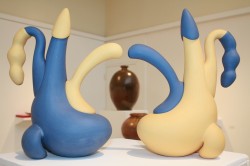Campus gallery show features many potters’ work

Potters and guests at the reception for the Art of the Potter exhibit Tuesday night in the Visual Arts Gallery enjoying the art and company. Several of the pottersʼ work can be seen, including works by Amanda Salov, Ted Vogel and Careen Stoll.
Bright colors, tantalizing features, warm earthy tones, and mixed materials, such as water or cloth, draw a visitor from one piece to the next at the “Art of the Potter” exhibit in the Visual Arts Gallery.
The exhibit, which opened Oct. 22, is a collection of works by 23 artists. Many are from the Portland metro area, others from the Eugene area.
Made of porcelain or clay, the pieces range “from very functional art pieces to much more cultural, non-utilitarian objects,” said Miles Browne, the Visual Arts Gallery coordinator. “It’s a good range to see the possibilities of what can be done with clay.”
All of the participants have a master’s degree in arts or fine arts. Some are instructors, including three from MHCC– Joe Davis, Stephen Mickey and Natalie Warrens – who all teach ceramics.
Davis brought the idea for the exhibition to Browne, who made the exhibit come together. The idea quickly expanded beyond pots. Davis said the focus of the exhibit is the interpretation of the vessel in its many forms.
He decided to invite only those artists with master’s degrees to narrow the list of great potters he knows. “In the end, I really wanted a highly developed bunch of work in the show,” he said.
A reception held Tuesday night gave people a chance to look over the pieces and talk with the artists, some of whom discussed their work with the audience.

ʻHengja Pairʼ, created by Joe Davis, facing tip to tip, is two pieces; ʻPhalicus Spoonilʼ, another Davis piece on the wall behind, is three pieces.
Several Davis pieces are on exhibit. The “Hengja Pair” were done for his thesis in 2007, while “Phalicus Spoonil” were completed the next year. Both are representative of the vessel.
“The whole idea behind the thesis work (and the later work)… was really kind of a play on the sexual references that are inherent in a lot of pots, pouring vessels and spouts,” he said.
Davis was not interested in ceramics until college.
“I actually entered art school thinking I would do metalsmithing,” he said. His parents, already worried about his decision, helped steer Davis into ceramics instead.
Having come from a practical-minded family, “I wanted something practical,” said Davis. “To go into art school was already a stretch.”
Ceramics, with its ability to make usable objects as well as art, gave him what he was seeking.
Davis was told by his graduate school instructors to stop looking at periodicals centered on contemporary ceramics, and go beyond the traditional.
“I’ve had talented hands for a long time but I didn’t really have any ideas about how to develop my work,” he said. One idea struck home, however.
“I was also interested in the idea of specimens,” Davis said. He credits photographer Karl Blossfeldt, who photographed dried plant specimens in the 1930s. Blossfeldt’s influence can be seen in the “Phalicus Spoonil” piece.
Jillian Croy, who attends a life drawing class at MHCC, came to view the pottery. She liked the “Phalicus Spoonil” piece, a lot. “There are many interpretations as to what it could be,” she said.
“The idea behind pots is really interesting to me,” Davis said. “I’ve made my life of it.
“In all the work I’ve done, even the sculptural work like this, there’s always been a reference to the vessel,” he explained. “Inside, outside, form, texture, some with color, (on) some of them I decided to completely remove color.”
Whether his work is functional or not, Davis said, “I’m a potter. I can’t get away from it.”
Ted Vogel and Careen Stoll, whose work is displayed, describe a tight-knit community of potters. “We end up knowing each other and a lot of what we do becomes a group process,” Stoll said.
“We share studios, share food,” Vogel added.
Potters are “typically pretty gregarious people,” Stoll said. “It comes with the territory.”
Vogel said his pieces are about the formal relationships between color and other materials. This is evident in his side-by-side pieces, “Orange Float” and “Turquoise Float.”
“Oval Vessels” and “Oblong Vessels” are a different direction for potter Amanda Salov, who has molded clay since childhood.
Salov said it’s not realistic for artists to “wait for an idea” for new pottery and sculptures. She prefers to experiment. “Working through ideas, then you come up with more. That’s how it works for me, anyway.”
She told the gallery audience her pieces are meant to be touched, the intent being to draw on the senses.
Katheryn Finnerty, a potter for 15 years, spoke about her recent work “The Fragment Series,” which reflects the fragments of her life.
After Finnerty was laid up by surgery, she found “time to question healing and growth, recovery, and what is new, what is old,” she said.
She used broken pieces of pottery she had saved, fabrics and prints to create the series. “Nuclear Cherry Blossom” is another of her works on display.
Not all the potters were able to attend the exhibit forum. Those who were kept busy engaging guests, students and fellow artists.
For more information on the gallery, contact Miles Browne in the Visual Arts Gallery, 503-491-7309.

Leave a comment